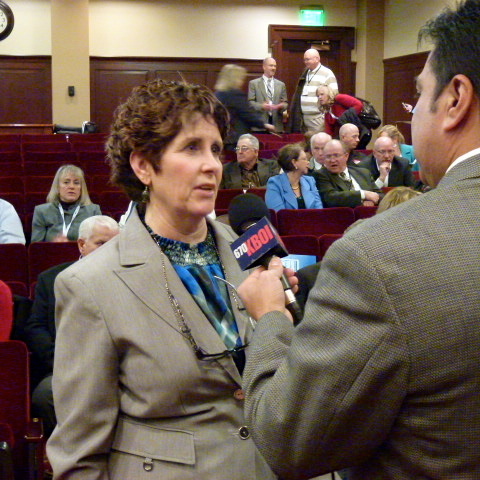
They still are three separate groups, with distinct memberships — the Idaho School Boards Association, the Idaho Association of School Administrators and the Idaho Education Association, the state’s teachers’ union.
But for most of the 2014 session, these three groups have spoken as one, with a good deal of success.
They are pushing for a teacher pay raise and teacher leadership “premiums.” They endorse a plan to begin reversing recession-era budget cuts. They support a controversial pilot exam aligned with the new Idaho Core Standards. A year after battling publicly over a series of labor laws, they even agree about keeping three of the laws on the books for another year.
And the stakeholder groups agree on two other points. They appreciate the improved working relationship, and know it will take effort to stay on the same side.
The recent history
A year ago, the stakeholders’ working relationship can best be described as complicated.
The IASA and the ISBA were sponsoring bills directly modeled after Proposition 1, the collective bargaining overhaul rejected by voters the previous November. They said their membership needed the financial and decision-making flexibility the legislation would provide. The IEA opposed most of these bills, labeling them as a series of “teacher attacks.”
At the same time, the groups were at the table, as part of Gov. Butch Otter’s education reform task force. The 31-member task force did not discuss labor issues — the group’s chairman, State Board of Education member Richard Westerberg, declared those off-limits at the start of the first meeting. The group instead worked on other topics, from teacher pay to school funding to technology, and forged nearly unanimous consensus around a far-ranging list of 20 recommendations.
IASA executive director Rob Winslow, ISBA executive director Karen Echeverria and IEA President Penni Cyr served on the task force. Since August, when the task force wrapped up its work, the three have advocated for the group’s most spendy recommendations: a teacher career ladder that could cost slightly more than a quarter billion dollars; and restoring $82 million in district “operational funding” cut during the recession. But they have maintained that the state needs to implement all 20 recommendations, and not pick and choose from the list.

Meanwhile, the stakeholders began working through differences on labor issues. Echeverria recalls one long meeting last summer to work through language to tighten the grievance process for non-certified staff, and tweak the appeal hearing process. “It wasn’t an easy morning,” she said. “(But) from there forward, I think we just opened up the lines of communication.”
The result: Two bills that have consensus support from education groups, passed the Legislature easily and are on Otter’s desk.
A (relatively) smooth session
For the most part, the stakeholder groups appear poised to get almost everything they wanted.
The proposed K-12 budget would restore $35 million in district “operational funding,” a high priority for the school boards and administrators. The budget includes $15.8 million for teacher leadership pay, a first step on establishing a career ladder. The budget also includes a 1 percent pay raise for teachers, a key bargaining point for the IEA.
Meanwhile, a legislative fight over the Idaho Core Standards never materialized. Some lawmakers grumbled about the Smarter Balanced Assessment Consortium exams designed to support the new standards, but the field test will roll out next month basically as planned.
The smooth session isn’t just a function of stakeholder harmony. Legislators have had more money to spend, said Sen. Janie Ward-Engelking, D-Boise, a retired teacher and a member of Otter’s task force. Many of the 2013 labor laws grew out of desperation; when the bulk of school budgets go to teacher pay and benefits, districts had no other place to look for savings.
“We all knew … that we were starving our schools to death,” she said. “I think last year was just a tough year.”
House Education Committee Chairman Reed DeMordaunt, an Eagle Republican and task force member, has seen a “big change” this session, and a welcome change. When the education groups agree, he said, lawmakers aren’t put in the awkward position of having to play referee.
But that doesn’t mean the stakeholders have always gotten their way. The House passed two bills that drew unanimous and vocal stakeholder opposition: a bill to rewrite the staff evaluation process, routed through DeMordaunt’s committee; and a bill offering $10 million in tax credits for private school scholarship donors.
Both bills appear sidetracked in the Senate. Still, Echeverria notes that lawmakers have clamored for education groups to get on the same page, so it rankles her when lawmakers go their own way.
“That’s been a little frustrating for all of us.”
Looking into the future

The stakeholder groups haven’t always agreed this session. For example, the IEA opposed a bill allowing rural school districts to hire the spouses of school trustees; the ISBA supported it.
But that was a minor difference of opinion, compared to 2013. And the groups seem to recognize that tougher discussions loom in the future:
- Two of the three labor laws, extended for one more year, remain contentious. The IEA agreed to an extension — but only to see how they’re working on the ground. “We’re all wanting to collect data and analyze that data,” Cyr said.
- The employee grievance bill — which attempts to spell out the grounds for a complaint, while striking the words “unfair treatment” from code — enjoys fragile consensus support. The IEA has signed on, but says it wants to see how, or if, the new language works.
- The mechanics of a career ladder still need to be worked out. A State Department of Education committee is working on the mechanics of the teacher licensure system, the linchpin for determining where teachers would land on the salary structure. DeMordaunt hopes the consensus holds, but he knows the groups have agreed only on the broad strokes of a career ladder. “There is probably going to be more debate.”
But even as the 2014 Legislature wraps up its work, the stakeholder groups are starting to meet behind the scenes, seeking common ground on the labor issues that could surface in 2015.
“I think it’s really healthy for the whole system,” Winslow said. “We’re going to work to keep it going.”
